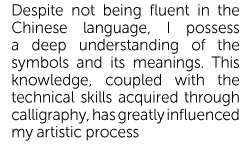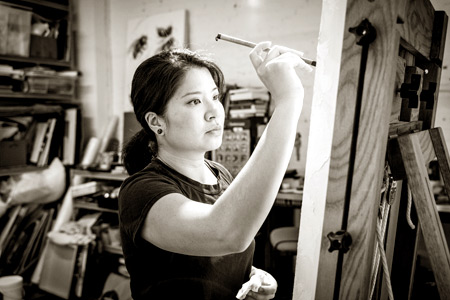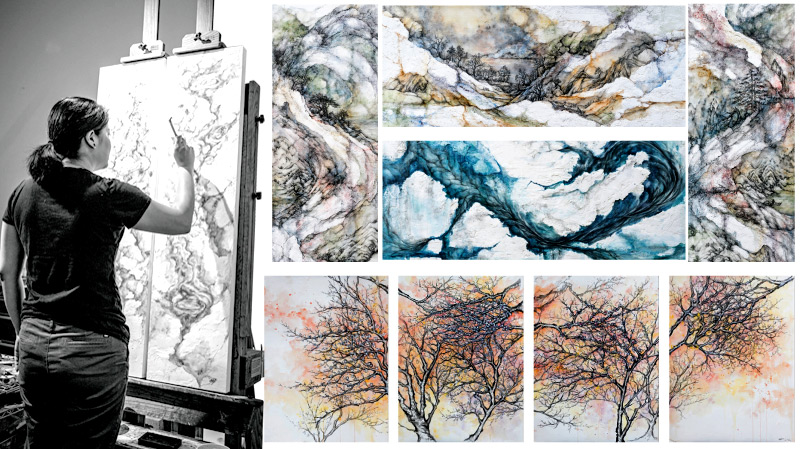In a charming fusion of Italian fresco techniques and Chinese brush painting, artist Cindy Shih traverses the complex interplay between tradition, identity, and narrative. Her journey, rooted in her Taiwanese heritage and immigrant experience, unfolds through layers of Venetian plaster, Sumi ink, and vivid pigments, each stroke echoing the whispers of nature and the echoes of her own story.
 Recently, the US Embassy hosted an exhibition of Cindy’s evocative artworks at their residency, underscoring the universal resonance of her themes.
Recently, the US Embassy hosted an exhibition of Cindy’s evocative artworks at their residency, underscoring the universal resonance of her themes.
Youth Observer had the opportunity to dig into Cindy’s world, exploring the depths of her creative process and her life’s artistic journey.
Born in Taiwan and immigrating to Los Angeles at the tender age of three, Cindy’s artistic journey began with her father’s teachings in Chinese calligraphy. This early immersion in traditional art forms laid the foundation for her unique artistic voice, blending Eastern and Western influences into a harmonious symphony of cultural expression.
At the recent welcome reception Julie J. Chung, Ambassador of the United States, lauded Cindy’s ability to bridge cultures and spark dialogue through her art. In a world often divided by boundaries, Cindy’s creations serve as a pillar of unity and understanding, offering glimpses into the shared human experience that transcends nationality and ethnicity.
Q: What initially inspired your fusion of Italian fresco techniques with Chinese brush painting in your artwork?
 A: Well, my exploration into various artistic styles and historical periods led me to this unique combination. What struck me about Italian fresco tradition was its presence not just in Italy, but also in China and Southeast Asia. It symbolizes how art transcends borders and eras, as ideas are shared across different cultures.
A: Well, my exploration into various artistic styles and historical periods led me to this unique combination. What struck me about Italian fresco tradition was its presence not just in Italy, but also in China and Southeast Asia. It symbolizes how art transcends borders and eras, as ideas are shared across different cultures.
Chinese brush painting has always been part of my heritage, as my dad, a calligrapher, taught me. About four years ago, amidst rising political turmoil, I felt compelled to reflect on the parallels between contemporary events and historical periods, particularly China’s warring times. This inspired me to create a series blending Eastern and Western influences.
I wanted the materials I used to reflect this narrative, combining the symbolism of Chinese landscape painting with Western materials like pigments and egg tempera. The juxtaposition of these elements allowed me to explore new contexts and create a dialogue between different artistic traditions.
Q: How has your background as an Asian influenced your artistic vision and the themes you explore in your art?
A: My background as an Asian has had a profound impact on my artistic perspective, especially living in the US as an Asian-American woman. I’ve often found myself in a space where I’m not entirely seen as American or fully embraced within my Asian-Chinese heritage. This sense of in-betweenness is a central theme in my work.
I draw inspiration from the concept of the “melancholy of race,” as discussed by Anne Anlin Cheng in her book of the same name. This notion resonates deeply with the immigrant experience, reflecting the feelings of being disconnected from one’s cultural roots while navigating the process of assimilation into a new society.
Through my art, I aim to capture the complexities of this experience, exploring themes of identity, belonging, and cultural displacement. I believe these sentiments are shared among immigrant communities and offer a glimpse into the universal human experience of searching for one’s place in the world.
Q: Could you elaborate on how your training in Chinese calligraphy informs your artistic process and style?
A: Chinese calligraphy plays a significant role in my artistic journey. It’s a tradition that I was introduced to at a young age by my father, as it’s customary for many Chinese individuals to learn it during their upbringing. While initially seen as tedious, the practice of calligraphy is invaluable as it trains both the mind and the hand, fostering a sense of focus and discipline that is essential for creativity.
Despite not being fluent in the Chinese language, I possess a deep understanding of the symbols and its meanings. This knowledge, coupled with the technical skills acquired through calligraphy, has greatly influenced my artistic process. Writing has always been a fundamental aspect of my creative expression, with each piece often beginning with extensive writing. It serves as a form of contemplation and allows me to articulate my thoughts and emotions.
Over time, the principles of Chinese calligraphy have become intertwined with my artistic approach. The fluidity of brush strokes and the deliberate placement of characters have become second nature, shaping the aesthetic and thematic elements of my work. As I explore various themes and ideas, the language of calligraphy emerges as a powerful tool for conveying my thoughts and adding depth to my artistic expression.
Q: Can you walk us through your artistic process, from the initial concept to the finished piece, focusing on how you integrate Venetian plaster, Sumi ink, and other pigments?
A: Certainly! My process typically begins with a series of works, each inspired by strong emotions or themes. I often start by journaling and sketching, using plaster or other materials to experiment with composition. Sumi ink, made from natural materials like tree sap, plays a central role. Its meditative preparation process and accessibility make it ideal for sketching and writing, integral parts of my creative process.
Transitioning to the actual artwork, I use plaster for its unique qualities—it’s both fragile and strong, echoing the immigrant experience of starting anew and facing challenges. This parallels my observations of urban transformation and gentrification, where destruction and growth coexist.
To preserve the integrity of my work, I carefully prime and coat the pieces with acrylic mediums, maintaining stability while highlighting the stories within textured surfaces. This meticulous process ensures that my artistic vision remains intact, even as the materials undergo transformation.
Q: How do you navigate the balance between preserving the integrity of Western-style fresco and Chinese landscape painting traditions while also incorporating your own artistic voice?
A: It’s been a bit of a struggle, honestly. There’s often this feeling of imposter syndrome as an artist, where I’m told my work doesn’t fit neatly into either traditional Chinese painting or Western landscape painting categories. But I’ve come to see the beauty in that space of blending cultures. America itself is a melting pot, and that’s reflected in the fusion of ingredients in our cuisine, like Korean-Mexican food trucks. It’s about creating something new from diverse influences.
I’ve learned not to apologize for this blending of influences; instead, I embrace it as part of my identity as an American artist. I’m grateful for the community of Asian American women artists I’ve found, as we support each other in navigating these challenges and creating our own unique voices. Growing up in America offers opportunities and freedoms that are truly special, and I don’t take that for granted.
Q: Your work often contemplates the elegance of line, texture, and brushwork. How do you approach the interplay between these elements to evoke the raw energy and power of nature in your pieces?
A: I find inspiration in the delicate yet powerful lines found in Chinese characters, and I strive to capture that simplicity and depth in my own work. Simultaneously, there’s a ruggedness in the materials I use — sometimes I feel like a construction worker, fully geared up, as I meticulously craft each piece.
I aim to balance these contrasting elements, portraying both the elegance of line and the rawness of the materials. I cherish the intimacy of traditional materials like graphite and ink, which speak to me on a personal level.
However, I also appreciate the importance of texture in breaking away from the monotony of flat surfaces that dominate our digital world.
For me, art should bear the imprint of the artist’s hand — the strokes and energy infused into each piece. This human touch, illuminated by light and life, is something I believe can’t be replicated by technology. It’s this unique beauty that I strive to capture and preserve in my work.
Q: You mentioned that your art touches upon issues of gender, race, and power. How do you translate these themes into visual language within your work?
A: Addressing these complex themes in a single piece of art is challenging. Instead, I explore them across multiple pieces within a series. Each artwork offers a different perspective, utilizing various visual languages and representations.
For instance, when I ended my engagement at 24 or 25, I felt compelled to convey the experience of shedding societal expectations.
This series focused on portraiture and realism, featuring different dresses symbolizing cultural and personal pressures. While this earlier work may differ stylistically from my current pieces, the underlying concepts remain consistent.
I believe it’s the conceptual thread and personal narratives that resonate with viewers, even as the artistic language evolves. Ultimately, it’s this connection with others that drives my creative exploration.
Q: What role do you see your art playing in contemporary discussions of immigration, and how do you hope viewers will engage with these themes through your work?
A: Immigration is a vast and complex topic, and I find it fascinating when viewers interpret my art in ways I hadn’t considered. I believe it’s essential for art to provoke diverse perspectives and responses.
Sometimes, reactions can be challenging, like when my parents attended my first show and were visibly upset. It’s still difficult for me to navigate those emotions, especially since my mom passed away recently. The grieving process is deeply personal and emotional.
Finding support within the Asian American community has been crucial for me, especially as I deal with these challenges. Older Asian American women, some in their seventies and eighties, have been like family to me, offering support and understanding. Now that I’m back in LA with my family, I realize the importance of having safe spaces and supportive communities.
I believe art has the power to foster dialogue and understanding around immigration issues, and I hope my work contributes to this conversation. Ultimately, I aim to create art that resonates with viewers and encourages them to reflect on their own experiences and perspectives.






